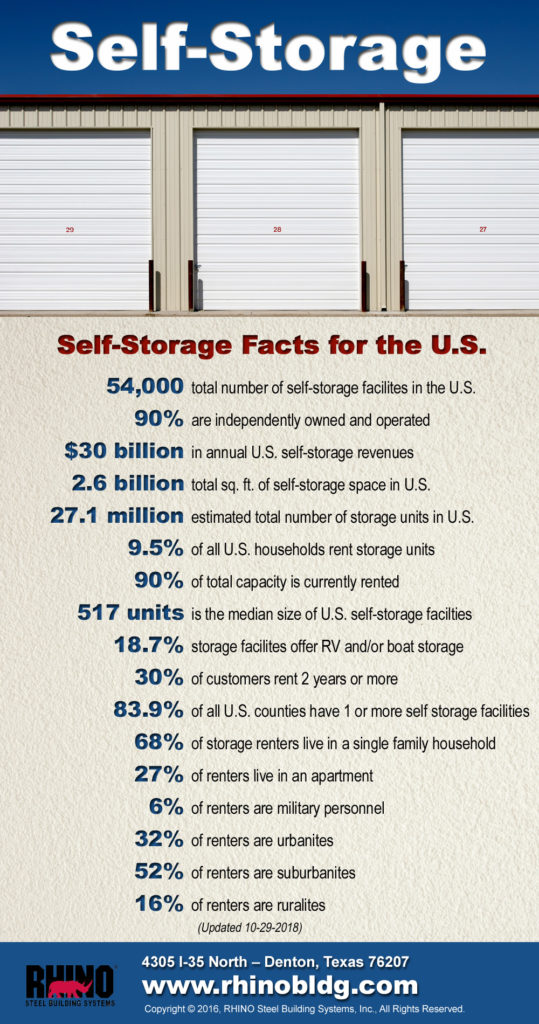The Race for Space in Our Homes and Businesses
Like any other successful U.S. business, the self-storage industry began as a solution to a need: SPACE.
Americans are perpetual collectors. We buy stuff, collect stuff, inherit stuff, create stuff, receive gifts of stuff— and we store stuff. The stronger the economy rises, the greater our addiction to stuff.
 Most U.S. homes contain about 300,000 individual items. Is it any wonder that one in ten Americans rent storage space?
Most U.S. homes contain about 300,000 individual items. Is it any wonder that one in ten Americans rent storage space?
Forward thinking American entrepreneurs foresaw the market for additional storage almost 60 years ago.
Self-Storage History
The first self-storage rental units began in Fort Lauderdale, Florida in the late 1950s. By the early 1960s, self-storage businesses began popping up all over Texas.
Public Storage— the largest of the publicly held storage companies— was founded in August 1972. They built first warehouse in Cajon, California. Two years later, the company had expanded to 20 warehouses. Today the Public Storage boasts 2,266 locations across the U.S., generating $2.38 billion in annual revenues.
Self-Storage Today
According to the Wall Street Journal, four “Ds” drive the success of the storage industry: death, divorce, downsizing, and dislocation. The first three are self-explanatory. Dislocation covers people requiring temporary storage due to job changes, buying new homes, marriages, college dorm shifts, or military deployment.
 Although the top five publicly owned storage giants operate over 6,000 facilities nationwide, the lion’s share of the market is privately held. Almost 80% of all self-storage businesses in the U.S. are independently owned and operated.
Although the top five publicly owned storage giants operate over 6,000 facilities nationwide, the lion’s share of the market is privately held. Almost 80% of all self-storage businesses in the U.S. are independently owned and operated.
Commercial businesses account for approximately 30% of rentals. Military personnel rent about 10%.
Consumers rent the majority of storage space. Sixty-eight percent of these renters live in a single-family home; 27% live in apartments.
The scope of the industry boggles the mind. According to data from the Self Storage Association (SSA):
- 87.5% of the 60,000 self-storage units worldwide are in the U.S.
- 2.5 billion sq. ft. of the storage space exists in the U.S.
- Total storage area is 78 square miles— roughly the size of Cincinnati, Ohio!
- The average self-storage facility covers 56,900 sq. ft.
- 170,000 people in the U.S. work in the self-storage industry
- The vast majority of self-storage buildings are single story
Pre-engineered Steel Self-Storage Buildings
When seeking a storage facility, people look for security, convenience, and cleanliness. They want some place safe to store their stuff.
That’s why storage companies overwhelming choose pre-engineered steel buildings when constructing their facilities.
RHINO steel mini-warehouse buildings provide:
- Affordable pricing
- Built-in resistance to termites, vermin, fire, storms, and lightning
- Discounted insurance
- Easy expansion
- Easy maintenance
- Energy-saving insulation packages for climate controlled facilities
- Environmentally-friendly recycled structural materials
- Eye-pleasing color choices
- Fast and simple construction
- Greater strength and protection from the elements
- Strong, long-lasting storage unit doors
- Superior waterproofing features
- Tall, unobstructed structures for RV and boat storage
RHINO ships ready-to-erect self-storage buildings all across North America.
Call the RHINO hotline today at 940.383.9566 for more information on min-warehouse structures. Our experienced metal buildings specialists can answer all your questions, provide expert advice, and produce a quick quote for your project.
